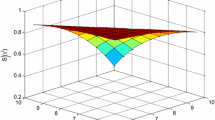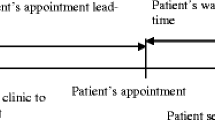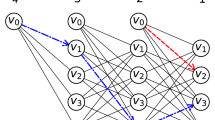Abstract
Efficient location of medical services is an issue of paramount importance in healthcare strategic planning. In this research, a mathematical model is developed for the location of multi-service health centers, assuming probabilistic demand and service time. Since patients may be shifted to another service after receiving a service by doctors’ order, health system is considered a Jackson queueing network. We assume that patients have “probabilistic choice behavior” and the primary factors contributing to their choice of one center over another are their proximity to the center and the number of medical services offered by the center. The proposed mixed integer nonlinear programming model seeks to minimize the demand weighted total distance travelled by patients among their residential areas and health centers and also among health centers on the one hand, and the weighted sum of undesired deviations from standard arrival rates at service stations on the other hand. The location of health centers as well as the type of services they offer and the number of servers at each service station are the main determinants of the proposed model. Using the proposed model, we can predict patients’ choice patterns and their arrival rates at current or newly provided medical stations. Two heuristics are developed to solve medium and large instances of the proposed model. The computational results obtained from benchmark instances show that the GA-based heuristic is somewhat better than the heuristic based on remove–add-–exchange procedures.






Similar content being viewed by others
Notes
General Algebraic Modeling System.
Basic Open-source Nonlinear Mixed Integer programming.
References
Aboolian R, Berman O, Drezner Z (2008) Location and allocation of service units on a congested network. IIE Trans 40:422–433
Afshari H, Peng Q (2014) Challenges and solutions for location of healthcare facilities. Ind Eng Manag 3(2):1–12
Ahmadi-Javid A, Seyedi P, Syam S S (2017) A survey of healthcare facility location. Comput Oper Res 79:223–263
Batty M (1978) Reilly’s challenge: new laws of retail gravitation which define systems of central places. Environ Plan A 10:185–219
Beheshtifar S, Alimoahmmadi A (2015) A multi-objective optimization approach for location-allocation of clinics. Int Trans Oper Res 22(2):313–328
Benneyan J, Musdal H, Ceyhan M, Shiner B, Watts B (2012) Specialty care single and multi-period location allocation models within the Veterans Health Administration. Socio-Econ Plan Sci 46:136–148
Boffey B, Galvão R, Espejo L (2007) A review of congestion models in the location of facilities with immobile servers. Eur J Oper Res 178:643–662
Bruni M, Conforti D, Sicilia N, Trotta S (2006) A new organ transplantation location–allocation policy: a case study of Italy. Health Care Manag Sci 9:125–142
Church R, Revelle C (1974) The maximal covering location problem. Pap Reg Sci 32:101–187
Daskin M, Dean L (2004) Location of healthcare facilities. In: A handbook of methods and applications, 43–76
Gross M, Harris C (1985) Fundamentals of queueing theory, chapter 4: networks, series and cyclic queues, 2nd edn. Wiley, New York, pp 229–230
Güneş ED, Nickel S (2015) Location problems in healthcare. In: Location science. Springer, Berlin, 555–579
Guo M, Zhang Z, Wua S, Song J (2013) Efficiency evaluation for allocating community-based health services. Comput Ind Eng 65:395–401
Harpera PR, Shahania AK, Gallagherb JE, Bowiec C (2005) Planning health services with explicit geographical considerations: a stochastic location–allocation approach. Omega 33:141–152
Huff D (1963) A probabilistic analysis of shopping center trade areas. Land Econ 1:81–90
Kim Y, Kim D (2013) A lagrangian heuristic algorithm for a public healthcare. Ann Oper Res 206:221–240
Marianov V, Serra D (1998) Probabilistic maximal covering location-allocation for congested system. J Reg Sci 38:401–424
Marianov V, Serra D (2002) Location–allocation of multiple-server service centers with constrained queues or waiting times. Ann Oper Res 111(1–4):35–50
Marianov V, Rıos M, Icaza M (2008) Facility location for market capture when users rank facilities by shorter travel and waiting times. Eur J Oper Res 191:32–44
McFadden D (1974) Conditional logit analysis of quantitative choice behavior. In: Zarembkar P (ed) Frontiers in economics. Academic Press, New York
Panwar M, Rathi K (2014) Social sustainability: contextual facility location planning model for multi-facility hierarchical healthcare system in India. Int J Appl Eng Res 9(3):275–284
Pasandideh SHR, Niaki STA (2012) Genetic application in a facility location problem with random demand within queuing framework. J Intell Manuf 23:651–659
Revelle CS, Swain RW (1970) Central facilities location. Geogr Anal 2(1):30–42
Roberto D, Galvao A, Gonzalo L, Acosta Espejo A, Boffey B (2002) A hierarchical model for the location of perinatal facilities in the municipality of Rio de Janeiro. Eur J Oper Res 138:495–517
Syam SS, Côte MJ (2010) A location allocation model for service providers with application to not-for-profit. Healthc Organ Omega 38:155–166
Teixeira JC, Antunes AP (2008) A hierarchical location model for public facility planning. Eur J Oper Res 185:92–104
Toregas C (1970) A covering formulation for the location of public service facilities. M.S. thesis, Cornell University
Vidyarthi N, Kuzgunkaya O (2015) The impact of directed choice on the design of preventive healthcare facility network under congestion. Health Care Manag Sci 18(4):459–474
Vidyarthi N, Jayaswal S (2014) Efficient solution of a class of location–allocation problems with stochastic demand and congestion. Comput Oper Res 48:20–30
Zhang Y, Berman O, Verter V (2009) Incorporating congestion in preventive healthcare facility network design. Eur J Oper Res 198:922–935
Zhang Y, Berman O, Marcotte P, Verter V (2010) A bilevel model for preventive healthcare facility network design with congestion. IIE Trans 42(12):865–880
Zhang Y, Berman D, Verter V (2012) The impact of client choice on preventive healthcare facility network design. OR Spectrum 34:349–370
Author information
Authors and Affiliations
Corresponding author
Rights and permissions
About this article
Cite this article
Radman, M., Eshghi, K. Designing a multi-service healthcare network based on the impact of patients’ flow among medical services. OR Spectrum 40, 637–678 (2018). https://doi.org/10.1007/s00291-018-0519-1
Received:
Accepted:
Published:
Issue Date:
DOI: https://doi.org/10.1007/s00291-018-0519-1




